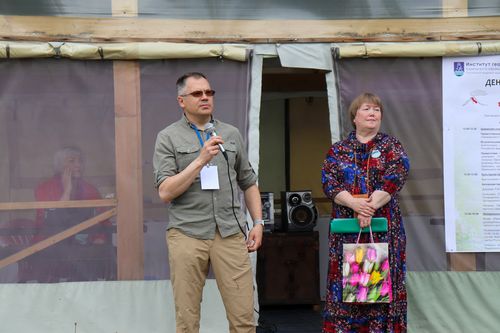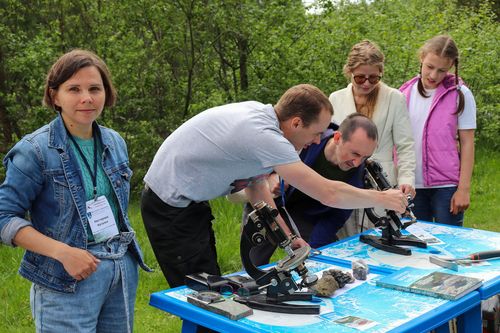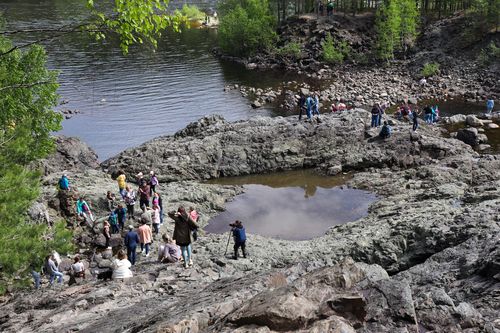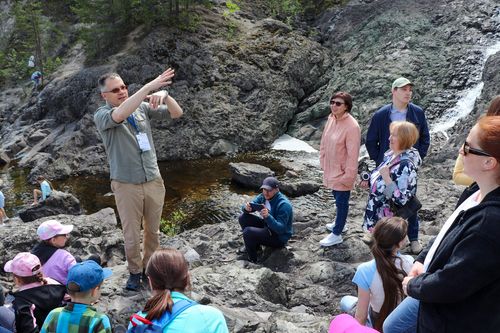The paleovolcano was discovered by Karelian geologists in the mid-20th century, after the Suna River channel had been emptied for constructing Palyeozerskaya hydroelectric power plant (HPP).
– At that time, our researchers worked quite actively in Kamchatka, studying active volcanoes. So when they saw the exposed riverbed in Girvas, they realized it was lava fragments very similar to those they had seen in Kamchatka. A scientific article was then written, reviewed by experts, and published. The professional community acknowledged: a relict paleovolcano worth being studied and demonstrated has been discovered, – told Director of the Institute of Geology KarRC RAS, Doctor of Geology and Mineralogy Sergey Svetov.

The Girvas Paleovolcano Park was founded in the geological site, which operated under the institute’s expert supervision. On June 12th, the park turned 7 years. This was the event to which the organizers timed the first Girval Paleovolcano Day and the opening of the museum featuring a collection of the Kondopoga District minerals, rock species, and ores.
– In the 1990’s, the site was a woesome spectacle as the surroundings were in poor condition. Things are getting better thanks to the park’s administration and the active citizens who work here. This is a unique destination and we believe the Girval Paleovolcano Day is an adequate event to celebrate it, – Sergey Svetov remarked.
Guests in the opening ceremony were welcomed also by the Girvas Paleovolcano Park Director Roza Efimova, Head of the Grivas settlement cluster Olga Sivokon’, and Palyeozerskaya HPP Director Vladimir Kruglov. The ceremony included a performance by Lukonoja group and a presentation of thematic publications. The audience was familiarized with the guidebook “Geological Heritage of Karelia” produced by staff of the Institute of Geology KarRC RAS, the book “Girvas Volcano” by Tatyana Dudinova, and the dictionary “Yurkostrov: a world of words and names. Glossary of the local Ludic Karelian patois” (compiled by Chief Researcher at the Institute of Linguistics, Literature and History KarRC RAS Irma Mullonen).

The agenda of the Day was mostly dedicated to popularization of geological knowledge. Young researchers from the Institute of Geology KarRC RAS Natalia Nesterova and Oleg Maksimov together with student from the St. Petersburg State University Angelina Petrakova prepared games and quizzes for the participants, demonstrated the tools and gear that geologists use in their work, and let the guests examine thin rock sections under the microscope. Director of the Museum of Precambrian Geology of the Institute of Geology KarRC RAS Oleg Lavrov introduced the first visitors to the collection of minerals. Junior Researcher at the Museum of Precambrian Geology and Leader of the Archean Young Geologists Club Alexandra Rakhmanova guided a tour of the paleovolcano for children, and Director of the Institute of Geology KarRC RAS Sergey Svetov repeated the story about the volcano for three adult groups.
The institute’s director remarked that the Internet has many myths regarding this place of interest. Scientists told the guests in a popular manner about what this relict paleovolcano really is today. The key advice to anyone only planning to visit the place is to study the available information beforehand to be prepared. Reliable information can be found in the guidebook “Geological Heritage of Karelia” (available in Russian in open access – link).
– These rocks are like a book: you need to know the alphabet to read it. We tried to relate scientific facts in plain language to make local people feel proud of their land. Karelia is matchless, we have lots of unique and rare objects, – Sergey Svetov added.

Girvas Palaeovolcano Day gathered over a hundred participants. It can turn into a tradition for the village. Scientists, on the other hand, plan to continue popularizing geological knowledge for other noteworthy destinations in Karelia, which appear in the guidebook.




